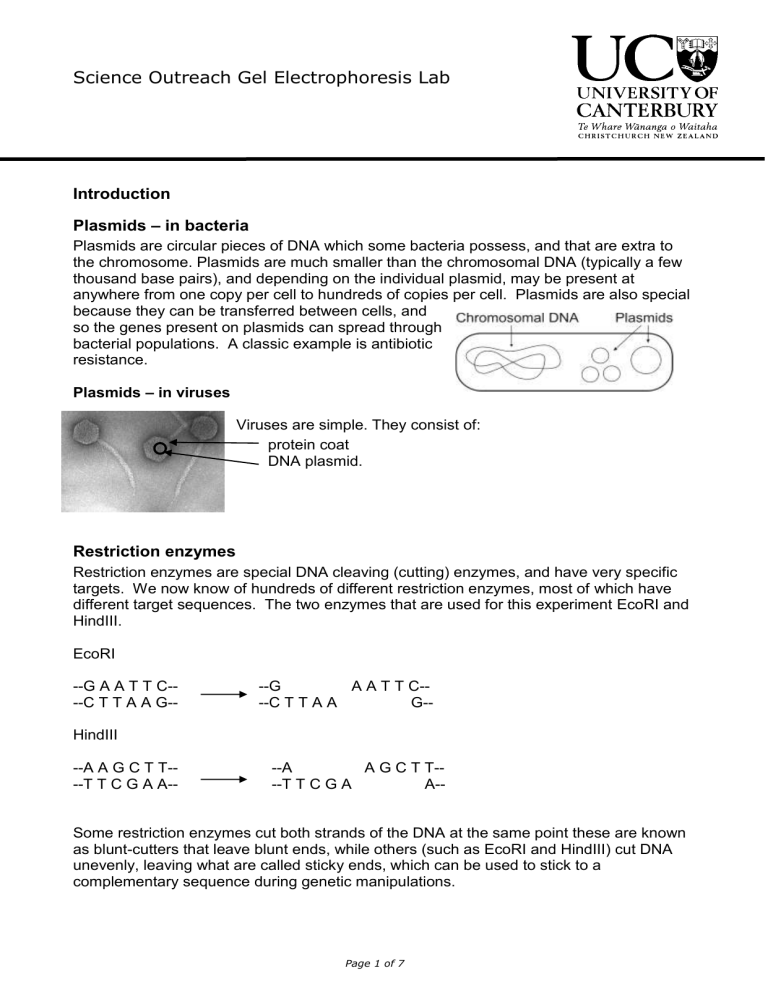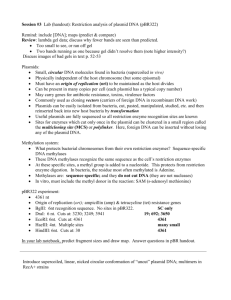Electrophoresis information for students

Science Outreach Gel Electrophoresis Lab
Introduction
Plasmids – in bacteria
Plasmids are circular pieces of DNA which some bacteria possess, and that are extra to the chromosome. Plasmids are much smaller than the chromosomal DNA (typically a few thousand base pairs), and depending on the individual plasmid, may be present at anywhere from one copy per cell to hundreds of copies per cell. Plasmids are also special because they can be transferred between cells, and so the genes present on plasmids can spread through bacterial populations. A classic example is antibiotic resistance.
Plasmids – in viruses
Viruses are simple. They consist of: protein coat
DNA plasmid.
Restriction enzymes
Restriction enzymes are special DNA cleaving (cutting) enzymes, and have very specific targets. We now know of hundreds of different restriction enzymes, most of which have different target sequences. The two enzymes that are used for this experiment EcoRI and
HindIII.
EcoRI
--G A A T T C--
--C T T A A G--
--G
--C T T A A
A A T T C--
G--
HindIII
--A A G C T T--
--T T C G A A--
--A A G C T T--
--T T C G A A--
Some restriction enzymes cut both strands of the DNA at the same point these are known as blunt-cutters that leave blunt ends, while others (such as EcoRI and HindIII) cut DNA unevenly, leaving what are called sticky ends, which can be used to stick to a complementary sequence during genetic manipulations.
Page 1 of 7
Agarose electrophoresis of DNA
Agarose (one of main components of agar) is a polysaccharide, isolated from seaweed. It forms a network of strands in a gel, which acts as a filter to separate molecules by size. The pores are quite large, so agarose is only useful for separating large molecules, such as DNA (a plasmid of 5 000 base pairs has a molecular weight of about 3.3 million daltons [daltons are also known as g/mol]; glucose is 180 Da, and proteins are usually in the order of 10 000 – 200 000 daltons, so DNA is very large).
When we run a gel, the smallest, most compact molecules run fastest as they can flow through the pores more easily, while larger molecules are held back. DNA is driven through the gel by an electric current. DNA is heavily negatively charged due to the phosphate groups in its backbone, so when we apply an electric current to a gel, the DNA migrates toward the positive electrode.
Supercoiled Nicked Linear
Intact plasmid DNA can run on a gel in a few different forms.The plasmid in its natural form is supercoiled, and so very compact. During purification, the plasmid can be nicked, which allows it to relax, and finally, sometimes during purification the DNA can be broken entirely to give linear plasmid.
These different types of DNA migrate at different rates – supercoiled runs the fastest, linear runs in the middle, and nicked plasmid runs the most slowly.
Once DNA has been linearised, it runs in a predictable
(fastest) (slowest) fashion proportional to its size. Multiple fragments can be identified on a gel as long as they are of sufficiently different sizes (approx 50-100 base pairs).
Cutting the DNA (already done for you)
In the lab, the λ bacteriophage plasmid was ‘cut’ with the restriction enzymes Hind III and EcoR I. This is called a restriction digest. The restriction digest takes about one hour at 37 ºC or it can be left at room temperature overnight. The cut DNA will then be run on a 1% E-gel pre-cast agarose gel and then viewed directly. The DNA fragments obtained can be analysed to calculate a restriction map for the plasmid.
The five eppendorf tubes* are labelled as U, (Uncut), H ( HindIII ), E ( EcoR I ), D (Double) and L
(Ladder).
A DNA ladder is a sample of known standard lengths of DNA. All the tubes contain 10 μL of liquid.
* You may have to shake or centrifuge the tubes so that the liquid settles to the bottom of the tube.
Gel electrophoresis
1. Preparing the samples
Make up your samples to 20 μL by adding 10μL distilled water to all the tubes of water to your tubes using a micropipette. Using a quick flicking motion get all the liquid to the bottom of the tube so that you can pipette it out, or use the “centrifuge”.
Page 2 of 7
1. Prepare your E-gel-EX
Take the packaging off the gel.
2. Removing the comb
Carefully remove the comb by lifting it from both sides without bending it. Pipette your samples and ladder into the desired wells; try to avoid introducing bubbles into the wells.
Fill any empty wells with 20 μL of distilled water.
3. Run the gel:
Place the gel on the grey iBase, right side first, sliding it across and pressing on the left side.
Use programme 7
“Run E-Gel EX” programme (find this by pressing Mode then the up arrow then press Go when you are ready). You can watch the progress of the gel using the Safe-Imager and the orange screen: place the iBase on top of the Safe-Imager with the orange screen over the gel, then press the red button on the Safe-Imager to turn on the light – your DNA bands will light up.
When the gels are finished (10 minutes), have a look at each of them using the Safe-Imager, and take photos if desired. The DNA will diffuse over time, so be sure to examine your gels shortly after they finish running.
If you have any problems call the invitrogen helpline : 0800 335 997
Page 3 of 7
Restriction map of
λ bacteriophage linear double-stranded DNA
This map shows where the two enzymes, HindIII and EcoR I will cut the plasmid in its linear form.
Complete the table:
Enzyme / s:
Number of
DNA fragments:
HindIII
EcoRI
HindIII & EcoRI
Sizes of the DNA fragments (base pairs):
Page 4 of 7
Lambda phage plasmid treated with:
HindIII EcoRI Both
25 000 -
20 000 -
15 000 -
10 000 -
8 000 -
5 000 -
4 000 -
2 000 -
1 500 -
1 000 -
800 -
600 -
400 -
300 -
200 -
150 -
100 -
75 -
50 -
Page 5 of 7
Draw in where you expect to find the
DNA bands
Lambda phage plasmid treated with:
HindIII
What to expect:
DNA Ladder:
A standard of known lengths of DNA
EcoRI
Page 6 of 7
Double: EcoRI and HindIII
Figure 1: Restriction Digest solution run on 1% E-gel EX electrophoresis kit for15 .
Lane 2: Uncut lambda DNA
Lane 3: EcoRI restriction [fragments 5804, 5643 are overlapping]
Lane 4: Hind III restriction [fragments 2322, 2027 are overlapping and 564, 125 are faint]
Lane 5: EcoRI & HindIII [5148 & 4973 ; 2027 & 1904 are overlapping. 831 and 564 are very faint]
Lane 6: DNA Ladder [400 and 200 are near the bottom of the gel]
Supplementary material: http://pathmicro.med.sc.edu/mayer/phage.htm
http://www.seyet.com/t4_academic.html
10
4
2
0.8
0.4
Page 7 of 7









